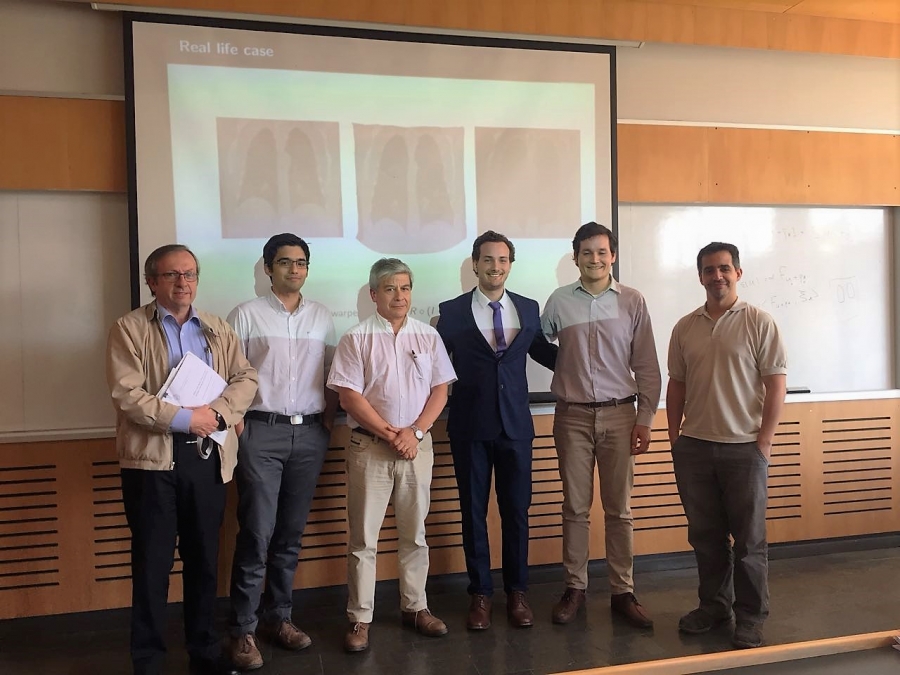News
Interdisciplinary study addressed a problem in Medicine area
Through imaging tests routinely given to patients in the area of Health, physicians obtain certain amount of data that allows them to examine more accurately and, thus, better diagnose a possible disease for, consequently, recommend the most appropriate treatment for recovery. However, the images obtained through these exams also contain other types of information that, if properly interpreted, could provide even more information so that doctors can make even better decisions.

This is, in summary, the premise of the study Primal and Mixed Finite Element Methods for Image Registration, corresponding to the thesis defended by Nicolás Barnafi to obtain the academic degree of Master of Science in Engineering from the Pontificia Universidad Católica de Chile, UC. Barnafi’s research, which obtained the highest grade, was directed by the researcher of the UC Daniel Hurtado and by the director of the Center for Research in Mathematical Engineering, CI²MA from Universidad de Concepción, Gabriel Gatica. The study proposes and analyzes primal, mixed and augmented formulations, as well as associated discretization schemes of finite elements, for the Problem of Registration of Deformable Images (DIR), including demonstrations of the applicability of the proposed method.
"The image registration method is actually used in many things, such as: alignment of panoramic photos for example, anatomical identification, detection of objects for military purposes and even growth of bacterial populations. Our case is motivated by the analysis of lung computed tomographies, which allow us to estimate the damage induced to patients receiving mechanical ventilation. It has been studied that stress generated by it are one of the most important causes in damage generation, and our method is particularly good for calculating stresses”, Barnafi explains about the specific applications of the method proposed in the study. In addition, he emphasizes that “the development of Mathematics has very practical applications, and hopefully more and more mathematicians will be interested in these challenges, because each answer leads to more difficult questions, and the Chilean industry has slowly learned to incorporate mathematical engineers as strategic pillars in technical development. The other important thing is that this work was successful thanks to the willingness of both advisors -Gatica and Hurtado- to collaborate, and I believe blindly that technical collaboration is essential to continue pushing science barriers. I would say that it is interdiscipline, but I think it is a somewhat overvalued term that does not make explicit the essential requirement of scientific bases for innovation with the greatest impact” Barnafi says.
Regarding the main conclusions of the study, the graduate states that “it is the simple question of knowing if the method we proposed works both theoretically and practically. The answer is finally yes, and it still presents many points of improvement, now thinking more about computational and clinical implementation. We have little evidence that the method works as we expect it to, but it depends on certain parameters that are difficult to calibrate, and the user of a software will not waste time calculating said constants. This becomes more relevant in a health center, where physicians just do not have time to review the method until it works well. Automation is a great challenge, and for image registration in particular there is still much work to be done”, Barnafi emphasizes regarding new studies that can be originated by the results achieved in his thesis.
In addition to the co-directors of the thesis, the Examination Commission of the exam consisted of academicians Carlos Sing-Long from Mathematical Engineering program, Matías Courdurier from Faculty of Mathematics, and Pedro Gazmuri, director of Master's in Industrial Engineering program, all of them from UC. “Thanks to the support of Daniel, Gabriel and many other teachers and officers, I managed to get everything in time to send my application to the Doctorate I will conduct in Milan, Italy. I will work on mathematical methods to solve biomechanical problems, but this time they will be oriented to hearts. It is a very ambitious project that seeks to generate models of the heart that work in real time. Those who are more up to date with the subject know that it is almost impossible to do this with current technology, so it will be a great challenge”, Barnafi explains about his plans to remain involved in border scientific research activities.

